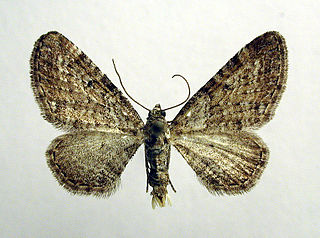
Eupithecia is the largest genus of moths of the family Geometridae, and the namesake and type genus of tribe Eupitheciini. Species in the genus are, like those of other genera in the tribe, commonly known as pugs. The genus is highly speciose, with over 1400 species, and members of the genus are present in most of the world with exception of Australasia. Roughly a quarter of described Eupithecia species occur in the Neotropical realm, where they have an especially high species diversity in the montane rain forests of the Andes. The genus includes a few agricultural pest species, such as the currant pug moth, Eupithecia assimilata, which is a pest on hops, and the cloaked pug moth, Eupithecia abietaria, which is a cone pest in spruce seed orchards.

The juniper pug or juniper looper is a moth of the family Geometridae. The species was first described by Michael Denis and Ignaz Schiffermüller in 1775. It is found throughout the Palearctic and in the Nearctic.

Mythimna separata, the northern armyworm, oriental armyworm or rice ear-cutting caterpillar, is a moth of the family Noctuidae. It is found in China, Japan, South-east Asia, India, eastern Australia, New Zealand, and some Pacific islands. It is one of the major pests of maize in Asia. The species was first described by Francis Walker in 1865.

Catocala separata is a moth of the family Erebidae first described by Christian Friedrich Freyer in 1846. It is found in the Balkans, the Mediterranean part of southern Turkey and the Levant.

Eupithecia satyrata, the satyr pug, is a species of moth of the family Geometridae. It was described by Jacob Hübner in 1813. It is found from Ireland, through northern and central Europe east to all of Russia and central Asia and western Siberia to Tibet. It is also present in North Africa and North America.

Eupithecia pernotata, or Guenée's pug, is a moth of the family Geometridae. The species was first described by Achille Guenée in 1857. It is known from the Alps, through Romania to southern Russia. It is also found in Finland.
Eupithecia accurata is a moth in the family Geometridae. It is found in Turkmenistan, Uzbekistan, northern Iran and Kazakhstan.

Eupithecia subbrunneata is a moth in the family Geometridae. It is found in China and Russia.
Eupithecia demetata is a moth in the family Geometridae. It is found in Turkmenistan.
Eupithecia duena is a moth in the family Geometridae. It is found in Ecuador and Peru.
Eupithecia interrubrescens is a moth in the family Geometridae. It is found in Tibet.
Eupithecia irambata is a moth in the family Geometridae. It is found in India (Sikkim).
Eupithecia junctifascia is a moth in the family Geometridae. It is found in Colombia and Costa Rica.
Eupithecia lacteolata is a moth in the family Geometridae. It is found in Russia and Turkey.
Eupithecia leucographata is a moth in the family Geometridae. It is found in Mexico.
Eupithecia mediobrunnea is a moth in the family Geometridae. It is found in Mexico.
Eupithecia mejala is a moth in the family Geometridae. It is found in Ecuador, Bolivia and Peru.
Eupithecia subsequaria is a moth in the family Geometridae. It is found in Turkey.
Eupithecia virescens is a moth in the family Geometridae. It is found in Brazil.

Hypomecis separata is a species of moth of the family Geometridae. It was first described by Francis Walker in 1863. It is found in Sri Lanka, India, Java and Borneo.







